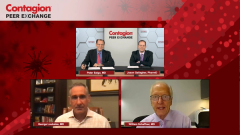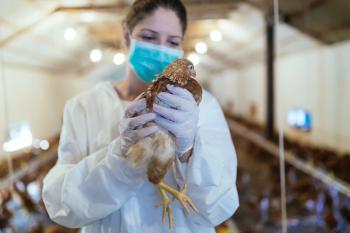
Impact of Lifting of COVID-19 Restrictions
A discussion on the lifting of COVID-19 restrictions and the potential impact on the upcoming flu season.
Episodes in this series

Transcript:
Peter Salgo, MD: We’re currently seeing the lifting of some of these COVID-19 restrictions, such as social distancing and masks. People are going indoors, to the theater, to movies, and they’re eating indoors—which by definition involves taking your mask off. What is the potential impact here? We’ve covered it, but I want to nail this down. It seems that whatever it may be doing for COVID-19 vis-à-vis the virus and the vaccine, flu is another issue.
Jason Gallagher, PharmD: One of many things we’ve learned in the past year is that all these interventions are effective when used together, but we don’t know which interventions accounted for which degree of effectiveness. If we all socially distanced and kids weren’t in school, whether they’re wearing masks or not is irrelevant. But as we peel those layers back one-by-one—and different states are doing natural experiments with different things—we’re going to see what the effects of those are. As is appropriate, as we move forward to whatever new reality we enter into, there’s going to be some degree of nonpharmaceutical interventions, such as masking, that are effective and employed here and not employed there. Who knows what impact that will have?
Peter Salgo, MD: Let me ask some questions. I don’t know the answers to these. I’m curious. There are parts of the world in which masking was widespread prior to this, including in some Asian communities, for example. How does their endogenous flu rate compare with ours, when we don’t mask or hadn’t masked in the past? Do we know?
William Schaffner, MD: I’m not sure. I don’t think those kinds of studies have been done. First of all, they’re difficult to do, and the other factor is that the degree of compliance with all these things vary within countries and over time, so it’s hard to study.
Peter Salgo, MD: I’m going to unscientifically take a leap here, but sort of a common-sense leap. George, is it fair to say that the lifting of a lot of these social distancing and masking restrictions, regarding COVID-19, is setting us up for another flu season?
George Loukatos, MD: I believe so. Because we are going through a second spike of COVID-19, not necessarily the flu, the best answer I can come up with is that although our masking and social distancing restrictions lifted pretty early, we did not see a spike then. What we’re seeing now with the Delta variant is that people who are unimmunized are the ones who are ending up hospitalized and in the ICU [intensive care unit]. If a permanent change comes with this, it may be that the populous will be more apt to get immunized with both flu and COVID-19 vaccines. As far as convincing people that masks are working, I think we’re further off in that.
Peter Salgo, MD: Let me peel that back a little, because you bundled 2 pieces in that answer. One is Delta variant, and the other is masking. If I heard you correctly, you said that prior to the Delta variant, we didn’t see a spike when we were beginning to unmask, then Delta came along. Is it the virus or is it behavior that’s causing the spike?
George Loukatos, MD: It’s the virus and its ability to mutate, which was our worst fear—that it would start imitating the flu and what the flu does. There are so many mutations of the flu, and that’s why we can never get rid of it. It’s become endemic. From a public health standpoint, that’s the drum I’ve been beating from the beginning; that we do not want to give this coronavirus an opportunity to start mutating like the flu does and become endemic. That is a question that is still up in the air, but it’s starting to lean toward becoming true and we may be dealing with COVID-19 yearly.
Peter Salgo, MD: One of the more interesting statements I heard, which makes perfect medical sense—I hope the public listened—is that the fewer people who get this, the fewer transmissions through people, the less the mutation rate should be, and the fewer newer Delta-like variants we’re going to see.
Jason Gallagher, PharmD: Absolutely. Viruses that are not replicating cannot mutate, so it’s an issue of how many susceptible hosts are out there for it. I want to tie a couple of things together here, though. It’s without a doubt driven largely by this variant, which is hyper transmissible compared with the earlier strains, but it caught us in a moment where our behavior had changed. It’s a combination of factors. It’s more the virus than anything else, but we’ve already taken our masks off and started to get together indoors more frequently, and it was opportunistic.
Peter Salgo, MD: We let our guard down just a little and along came Delta to take advantage of that. Is that fair?
William Schaffner, MD: Absolutely.
George Loukatos, MD: I will say, though, that living in the south where the social distancing and masking guidelines were never truly respected as a whole, unfortunately, that’s going to convince more people that, “Look, we weren’t wearing a mask since February, and through the spring and summer, and nothing happened until Delta came along.” My fear is that the public perception is going to be that masks and social distancing didn’t help and that it was more that this new virus is worse than the original.
Peter Salgo, MD: That brings us back to flu, right? It did help because flu went away for a year. I haven’t heard anybody making that case on television very much. Perhaps that’s something we should do.
Jason Gallagher, PharmD: I haven’t heard that either.
Peter Salgo, MD: I want to thank all of you out there for watching this Contagion® Peer Exchange. If you enjoyed the content, please subscribe for our e-newsletters to receive upcoming Peer Exchange segments and other great content right in your in-box.
Transcript edited for clarity.
Newsletter
Stay ahead of emerging infectious disease threats with expert insights and breaking research. Subscribe now to get updates delivered straight to your inbox.



















































































































































































































































































